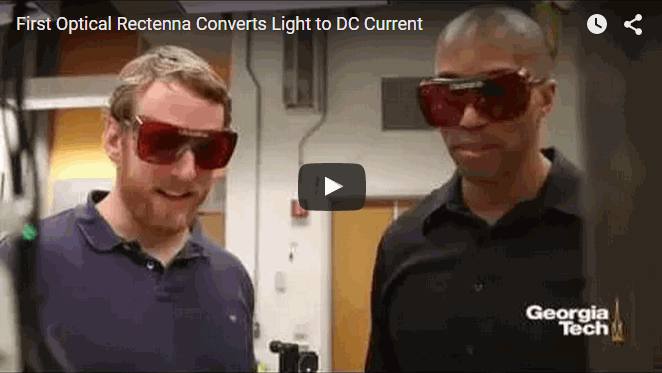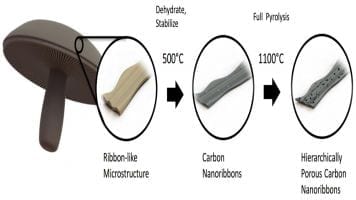
Using nanometer-scale components, researchers have demonstrated the first optical rectenna, a device that combines the functions of an antenna and a rectifier diode to convert light directly into DC current.
Potential to achieve 40 percent broad spectrum efficiency . . .
Based on multiwall carbon nanotubes and tiny rectifiers fabricated onto them, the optical rectennas could provide a new technology for photodetectors that would operate without the need for cooling, energy harvesters that would convert waste heat to electricity – and ultimately for a new way to efficiently capture solar energy.
In the new devices, developed by engineers at the Georgia Institute of Technology, the carbon nanotubes act as antennas to capture light from the sun or other sources. As the waves of light hit the nanotube antennas, they create an oscillating charge that moves through rectifier devices attached to them. The rectifiers switch on and off at record high petahertz speeds, creating a small direct current.
Billions of rectennas in an array can produce significant current, though the efficiency of the devices demonstrated so far remains below one percent. The researchers hope to boost that output through optimization techniques, and believe that a rectenna with commercial potential may be available within a year.
“We could ultimately make solar cells that are twice as efficient at a cost that is ten times lower, and that is to me an opportunity to change the world in a very big way” said Baratunde Cola, an associate professor in the George W. Woodruff School of Mechanical Engineering at Georgia Tech. “As a robust, high-temperature detector, these rectennas could be a completely disruptive technology if we can get to one percent efficiency. If we can get to higher efficiencies, we could apply it to energy conversion technologies and solar energy capture.”
The research, supported by the Defense Advanced Research Projects Agency (DARPA), the Space and Naval Warfare (SPAWAR) Systems Center and the Army Research Office (ARO), was reported September 28 in the journal Nature Nanotechnology.
Developed in the 1960s and 1970s, rectennas have operated at wavelengths as short as ten microns, but for more than 40 years researchers have been attempting to make devices at optical wavelengths. There were many challenges: making the antennas small enough to couple optical wavelengths, and fabricating a matching rectifier diode small enough and able to operate fast enough to capture the electromagnetic wave oscillations. But the potential of high efficiency and low cost kept scientists working on the technology.
“The physics and the scientific concepts have been out there,” said Cola. “Now was the perfect time to try some new things and make a device work, thanks to advances in fabrication technology.”
Read more: First Optical Rectenna – Combined Rectifier and Antenna – Converts Light to DC Current
The Latest on: Optical Rectenna
[google_news title=”” keyword=”Optical Rectenna” num_posts=”10″ blurb_length=”0″ show_thumb=”left”]
via Google News
The Latest on: Optical Rectenna
- optical mouseon May 1, 2024 at 5:00 pm
If your pointing device is a mouse, turn it over. The chances are you’ll see a red LED light if you’re not seriously old-school and your mouse has a ball, this light serves as the illumination ...
- The Best Optical Gaming Keyboards in 2024on April 28, 2024 at 1:36 am
The best optical gaming keyboards are quickly becoming a popular choice among gamers, thanks to fewer moving parts to go wrong, and a shorter actuation distance (a fancy way of saying you can type ...
- Optical illusion challenges people with 'most attentive' eyes to spot goat's owner in five secondson April 27, 2024 at 5:00 pm
If you can spot the goat's owner in this optical illusion, you've got the 'most attentive' eyes. This perplexing optical illusion is leaving many puzzled - but once you crack it, it will seem ...
- Optical Pumpingon April 27, 2024 at 6:44 am
Optical Pumping In this new technique of experimental physics light is used to "pump" electrons to higher energy-levels. The method is employed to study the interaction of atoms and radio waves ...
- Optical Illusion Vision Test: Find the comb in the library in 7 seconds!on April 25, 2024 at 10:11 am
The word illusion originates from the Latin verb illudere, meaning to mock or trick. Optical illusion images, cleverly crafted to deceive human perception, serve as straightforward tests for ...
- Optical Illusion Eye Test: Find the dog in the park in 7 seconds!on April 24, 2024 at 5:46 pm
Optical illusions are mind-bending images that have become popular among netizens in the last decade. These challenges test your perception and visual skills, helping scientists understand how our ...
- Individual polyatomic molecules are trapped in optical-tweezer arrayson April 23, 2024 at 5:00 pm
(Courtesy: iStock/Emilija Randjelovic) Individual polyatomic molecules have been trapped in arrays of optical tweezers for the first time. Researchers in the US were able to control individual quantum ...
- Going all opticalon April 21, 2024 at 5:00 pm
"TPUv4 accelerators are deployed in 'SuperPods' of 4,096 chips, each connected to a dedicated optical switch, which can dynamically reconfigure 4x4x4 chip cubes into arbitrary 3D torus topologies in ...
- Optical memory of crystalson April 14, 2024 at 5:00 pm
These devices can use light in more complex ways, such as for data analysis or information storage, and have potential applications ranging from advanced optical communication and sensing to machine ...
- Classical optical neural network exhibits 'quantum speedup'on April 2, 2024 at 1:05 pm
To address the issue, great efforts have been made in two research directions: optical neural networks and quantum neural networks. Optical neural networks utilize advanced optical manipulation ...
via Bing News











